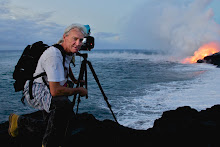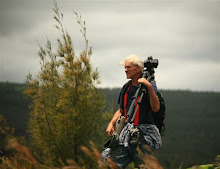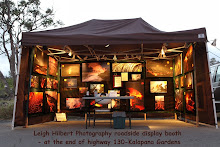 Crescent moon over an old Ohia tree at Kalapana Gardens last night.
Crescent moon over an old Ohia tree at Kalapana Gardens last night.This graph showing the recorded magma pressures of the Kilauea caldera’s surface and Pu`u O`o crater reveal the longest period of inactive deflation/inflation (D/I) swings I have ever seen; basically flat-lined for four days straight.
 The graph lines indicate there have been virtually no significant changes in pressures within the massive magma reservoir chambers and conduits, (though the graphs scale used here does not expose the many little ups and downs the pressure has gone through during the same period).
The graph lines indicate there have been virtually no significant changes in pressures within the massive magma reservoir chambers and conduits, (though the graphs scale used here does not expose the many little ups and downs the pressure has gone through during the same period). Above ground USGS has noted little change in the ongoing eruptive activity at the Halema’uma’u craters pit vent, nor at the venting Pu`u O`o; degassing at both vents, lava moving up & down inside the pit vent, and an incandescent glow on the Pu`u O`o crater floor last night, which I saw on the cam.
As for the eruptive activity along the coast -- down the Pulama pali, coastal plains and ocean entry. I looked over those areas from Kalapana Gardens at 9:30 PM last night. I could not see any surface lava activity anywhere along the lava tube system from the top of the pali to the bottom even though the lava tubes carry a large volume of molten lava below ground. I did, however, spot a faint bit of lava glow somewhere within the tube system that runs between the base of the pali and the old Quarry west of roads end. Other than that there is the ongoing July 25th, 2010 ocean entry, which I took a picture of from the access road and through a 400mm lens last night; posted below:

So that is the basics of eruptive activity and I will write the next update when something significantly changes with the lava flow, or in a day or two.
I have made no changes to the Lava viewing update for the Hawaii County Civil Defense public coastal site:
Public lava viewing is from the access road off the very end of Highway 130. There is a parking area, port-o-potties and security personnel on site between 2:00 Pm and 10:00 PM daily. Last car allowed in at 8:00 PM, but you can stay in the area until about 9:30 PM.
A half-mile walk down the road from the parking takes you to where recent lava covered it, as well as affording vista views of the lines of degassing fumes wafting from the underground lava tubes that presently carry tremendous amounts of liquid rock for miles down slope to the sea. And from the road you can see where the lava vigorously pours into the ocean and huge plumes of steam rise up. After dark the base of this steam will glow red and orange colors from reflective molten lava. Periodically there have been sizable surface flows of lava breaking out well within view of the access road; these breaks have often flowed close to, and on to, the viewing site these past months; conditions for that change weekly.
You can get on-site information updates for the public access road by phoning management personnel stationed there after 2:00 PM:
430-1966 or 217-2215. The main Civil Defense lava viewing hotline is 961-8093.
Walk-in tour groups can often be located at the vendors’ area of the county viewing parking, again, located off the very end of highway 130.
Hawaii Volcano National Park: Great views day and night of this impressive crater are from the Jaggar Museum balcony within the Hawaii Volcanoes National Park, depending on the weather; and the park is open to the public 24 hours a day with a nominal entrance fee by day.











No comments:
Post a Comment